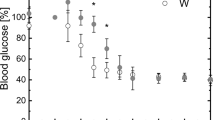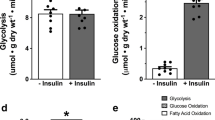Abstract
Cardiovascular complications are the primary cause of death for diabetic patients. Clinically, the development of dysfunctional cardiomyopathy is one of the main complications of diabetes. Experimental evidence indicates that the mitochondrion is one of the main sites implicated in the development of cardiac dysfunction. Yet, the precise cause and mechanisms involved in the process are largely debated. We report here that heart mitochondria from streptozotocin-induced diabetic Sprague-Dawley rats present a gradual reduction in state 3 oxygen consumption that reaches 35% by the fourth week following diabetes onset. Rats presenting a level of hyperglycemia similar to diabetic animals, but not showing the marked weight loss or appearance of urinary ketones typical of the later group present no decline in state 3 mitochondrial oxygen consumption, the values being indistinguishable from those of mitochondria from control animals. Mitochondria from hyperglycemic non-ketotic rats, however, show a 15–20% increase in state 4 respiration, but only when glutamate is used as energetic substrate. Mitochondria from diabetic rats, instead, show a 40–50% increase in state 4 respiration with glutamate and 20–25% with succinate as energetic substrate. Interestingly, hyperglycemic non-ketotic animals present a level of serum insulin intermediate between those of controls and diabetic animals. These functional modifications are unrelated to the time elapsed since the onset of diabetes, as they are observed at 2, 4, 6 as well as 8 and 12 weeks after diabetes onset. Taken together, these data argue against hyperglycemia per se being a direct cause of the decline in state 3 oxygen consumption observed in cardiac mitochondria of type-I diabetic rats. Rather, they point to insulin level and subsequent metabolic alterations as a possible cause for the insurgence of mitochondrial dysfunction. (Mol Cell Biochem 267: 31–37, 2004)
Similar content being viewed by others
References
Rodrigues B, McNeill JH: The diabetic heart: Metabolic causes for the development of a cardiomyopathy Cardiovasc Res 26: 913–922, 1992
Rodrigues B, Cam MC, McNeill JH: Myocardial substrate metabolism: Implications for diabetic cardiomyopathy. J Mol Cell Cardiol 27: 169–179, 1995
Rodrigues B, Cam MC, McNeill JH: Metabolic disturbances in diabetic cardiomyopathy. Mol Cell Biochem 180: 53–57, 1998
Hall JC, Sordahl LA, Stefko PL: The effect of insulin on oxidative phosphorylation in normal and diabetic mitochondria. J Biol Chem 235: 1536–1539, 1960
Kristal BS, Jackson CT, Chung HY, Matsuda M, Nguyen HD, Yu BP: Defects at center P underlie diabetes-associated mitochondrial dysfunction. Free Radic Biol Med 22: 823–833, 1997
Rinehart RW, Roberson J, Beattie DS: The effect of diabetes on protein synthesis and the respiratory chain of rat skeletal muscle and kidney mitochondria. Arch Biochem Biophys 213: 341–352, 1982
Pierce GN, Dhalla NS: Heart mitochondrial function in chronic experimental diabetes in rats. Can J Cardiol 1: 48–54, 1985
Factor SM, Okun EM, Minase T: Capillary microaneurysms in the human diabetic heart. N Engl J Med 302: 384–388, 1980
Fein FS, Kornstein LB, Strobeck JE, Capasso JM, Sonnenblick EH: Altered myocardial mechanics in diabetic rats. Circ Res 47: 922–933, 1980
Ganguly PK, Pierce GN, Dhalla KS, Dhalla NS: Defective sarcoplasmic reticular calcium transport in diabetic cardiomyopathy. Am J Physiol 244: E528–E535, 1983
Devereux RB, Roman MJ, Paranicas M, O'Grady MJ, Lee ET, Welty TK, Fabsitz RR, Robbins D, Rhoades ER, Howard BV: Impact of diabetes on cardiac structure and function: The strong heart study. Circulation 101: 2271–2276, 2000
Singh JP, Larson MG, O'Donnell CJ, Wilson PF, Tsuji H, Lloyd-Jones DM, Levy D: Association of hyperglycemia with reduced heart rate variability (The Framingham Heart Study). Am J Cardiol 86: 309–312, 2000
Francis GS: Diabetic cardiomyopathy: Fact or fiction? Heart 85: 247–248, 2001
Turko IV, Marcondes S, Murad F: Diabetes-associated nitration of tyrosine and inactivation of succinyl-CoA:3-oxoacid CoA-transferase. Am J Physiol Heart Circ. Physiol 281: H2289–H2294, 2001
Turko IV, Li L, Aulak KS, Stuehr DJ, Chang JY, Murad F: Protein tyrosine nitration in the mitochondria from diabetic mouse heart: Implications to dysfunctional mitochondria in diabetes. J Biol Chem 278: 33972–33977, 2003
Turko IV. Murad F: Quantitative protein profiling in heart mitochondria from diabetic rats. J Biol Chem 278: 35844–35849, 2003
Babsky A, Doliba N, Doliba N, Savchenko A, Wehrli S, Osbakken M: Na+ effects on mitochondrial respiration and oxidative phosphorylation in diabetic hearts. Exp Biol Med (Maywood. ) 226: 543–551, 2001
Uchida K: Role of reactive aldehyde in cardiovascular diseases. Free Radic Biol Med 28: 1685–1696, 2000
Rosca MG, Monnier VM, Szweda LI, Weiss MF: Alterations in renal mitochondrial respiration in response to the reactive oxoaldehyde methylglyoxal. Am J Physiol Renal Physiol 283: F52–F59, 2002
Ohkuwa T, Sato Y, Naoi M: Hydroxyl radical formation in diabetic rats induced by streptozotocin. Life Sci 56: 1789–1798, 1995
Kakkar R, Mantha SV, Radhi J, Prasad K, Kalra, J: Increased oxidative stress in rat liver and pancreas during progression of streptozotocin-induced diabetes. Clin Sci (Lond) 94: 623–632, 1998
Kakkar R, Kalra J, Mantha SV, Prasad K: Lipid peroxidation and activity of antioxidant enzymes in diabetic rats. Mol Cell Biochem 151: 113–119, 1995
Stanley WC, Lopaschuk GD, McCormack JG: Regulation of energy substrate metabolism in the diabetic heart. Cardiovasc Res 34: 25–33, 1997
Yan SF, Ramasamy R, Naka Y, Schmidt AM: Glycation, inflammation, and RAGE: A scaffold for the macrovascular complications of diabetes and beyond. Circ Res 93: 1159–1169, 2003
Asayama K, Hayashibe H, Dobashi K, Niitsu T, Miyao A, Kato K: Antioxidant enzyme status and lipid peroxidation in various tissues of diabetic and starved rats. Diabetes Res 12: 85–91, 1989
Misra T, Gilchrist JS, Russell JC, Pierce GN: Cardiac myofibrillar and sarcoplasmic reticulum function are not depressed in insulin-resistant JCR:LA-cp rats. Am J Physiol 276: H1811–H1817, 1999
Kim HW, Ch YS, Lee HR, Park SY, Kim YH: Diabetic alterations in cardiac sarcoplasmic reticulum Ca2+-ATPase and phospholamban protein expression. Life Sci 70: 367–379, 2001
Author information
Authors and Affiliations
Rights and permissions
About this article
Cite this article
Lashin, O., Romani, A. Hyperglycemia does not alter state 3 respiration in cardiac mitochondria from type-I diabetic rats. Mol Cell Biochem 267, 31–37 (2004). https://doi.org/10.1023/B:MCBI.0000049360.75392.89
Issue Date:
DOI: https://doi.org/10.1023/B:MCBI.0000049360.75392.89




